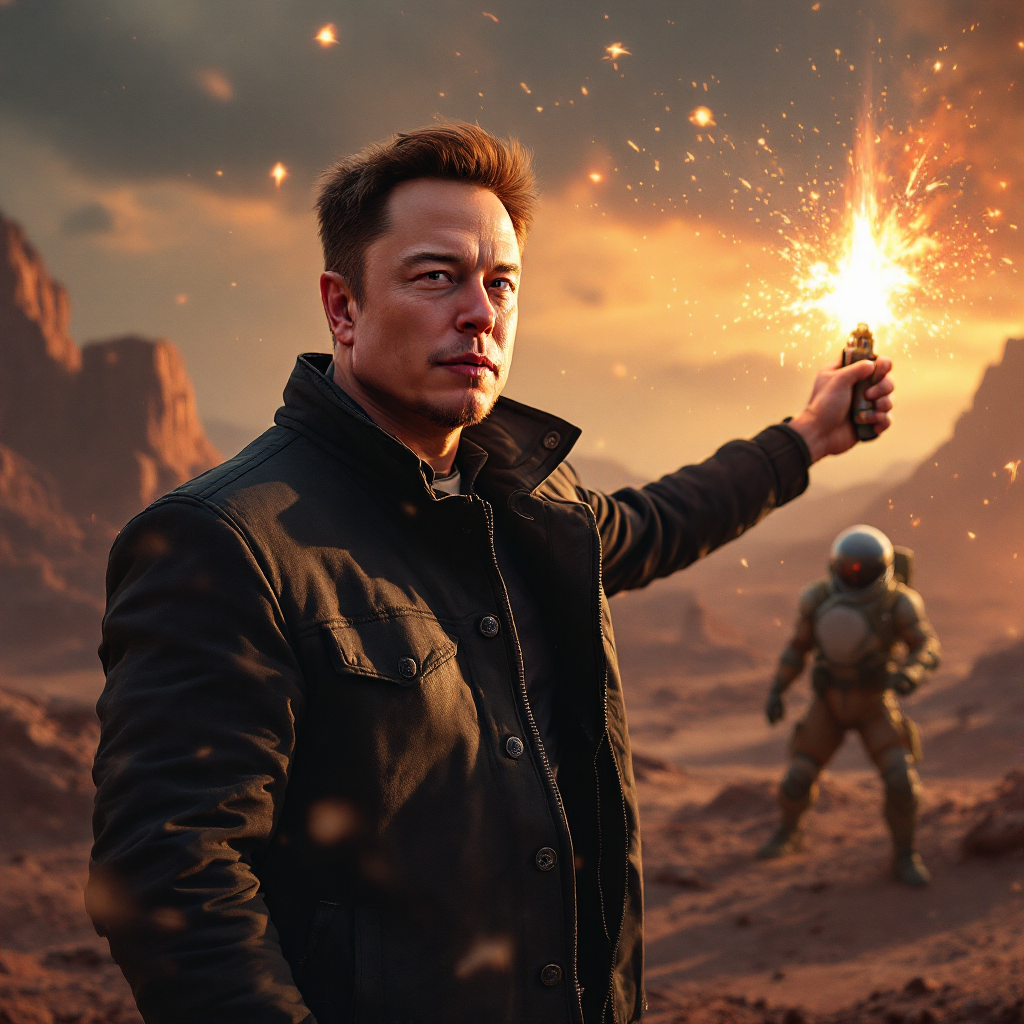Elon's Plan
This briefing analyzes a document outlining Elon Musk's overarching goals, connecting his various ventures to a central theme: propelling humanity towards a Type I civilization on the Kardashev Scale.

In the vast landscape of technological innovation and entrepreneurship, few figures have pursued a vision as ambitious and interconnected as Elon Musk. While his various ventures might appear diverse on the surface - from electric cars to space exploration, social media to brain-computer interfaces - they are all pieces of a singular, overarching goal: propelling humanity toward becoming what scientists call a Type I civilization on the Kardashev Scale.
This classification, which might sound like science fiction to many, represents a society capable of harnessing and utilizing all the energy resources available on its planet. At the heart of Musk's strategy lies a fundamental belief in solar power as the bedrock of humanity's energy future, with his bold prediction that it will eventually comprise more than 99% of global power generation.
The roadmap to this future, however, isn't simply about developing better solar panels or more efficient batteries. Through his constellation of companies - Tesla, SpaceX, Neuralink, The Boring Company, xAI, and X (formerly Twitter) - Musk is systematically addressing what he sees as the critical bottlenecks holding humanity back from this evolutionary leap. These range from regulatory hurdles and infrastructure limitations to the very ways humans interface with technology.
As artificial intelligence demands ever-increasing amounts of energy and humanity's technological capabilities expand, Musk's integrated approach to solving these challenges reveals a carefully constructed strategy that extends far beyond individual business successes. Each venture serves as a building block in a larger architecture designed to transform how civilization generates, stores, and utilizes energy - essentially rewriting humanity's relationship with technology and power consumption.
Do we forget our Nation's moral culture as quoted by John Adams or go with economic/technical gains at any cost?
“Government is instituted for the common good; for the protection, safety, prosperity and happiness of the people; and not for the profit, honor, or private interest of any one man, family, or class of men and to reform, alter, or totally change the same, when their protection, safety, prosperity and happiness require it.” - John Adams
This analysis explores how each piece of Musk's industrial empire fits into this grand vision, examining the interconnections between his various ventures and their collective role in pushing humanity toward a new era of energy abundance and technological advancement. But at what cost? Do we lose sight of what made the USA great and continue the past mistakes or do we just keep marching forward blindly?
“Government is instituted for the common good; for the protection, safety, prosperity, and happiness of the people; and not for profit, honor, or private interest of any one man, family, or class of men.” John Adams
Elon Musk’s overarching aim appears to be propelling humanity toward a Type I civilization—a society that taps nearly all the energy resources available on its planet, primarily from the Sun. He sees solar power as the long-term bedrock of global energy generation and identifies regulatory hurdles as a key bottleneck limiting widespread solar adoption.
Details
- First-Principles Thinking
- Musk’s approach: “Boil things down to the fundamental truths and reason up from there.”
- Applied to energy, this means recognizing that Earth already receives vast amounts of solar energy sufficient to power civilization many times over.
- Kardashev Scale & Solar
- By referencing the Kardashev Scale, Musk ties progress to the expansion of energy capacity.
- Solar power, being direct from the Sun, is the main path to scaling energy generation beyond fossil fuels.
- In the very long run, he estimates “solar will be >99% of all power generation.”
- Bottlenecks to Large-Scale Solar
- Musk stresses that “Regulation is literally the bottleneck to Kardashev scale ascension.”
- To eliminate bottlenecks, he works through Trump and pushes forward with streamlined regulation or technological advancements that reduce costs and accelerate adoption.
- AI’s Enormous Energy Needs
- Musk acknowledges that advanced AI demands “nearly double what we currently generate for the entire nation.”
- He invests billions in AI supercomputers, reinforcing the need for massive clean energy sources like solar.
Insights
Musk’s end goal is to eliminate the roadblocks—both regulatory and technical—that keep humanity from fully harnessing solar energy. By doing so, he aims to supply the immense power demands of AI and other future technologies. In simpler terms, he’s pushing to scale up solar power so that civilization can ascend the Kardashev Scale and become a thriving, sustainable, and technologically advanced global society.
Elon Musk’s efforts—from electric vehicles to rocket launches—can be seen as building blocks toward a society that harnesses massive amounts of renewable energy (primarily solar) and ascends the Kardashev Scale. Each project chips away at bottlenecks—whether technical, regulatory, or infrastructural—on the road to a clean, high-energy future that supports everything from AI supercomputers to interplanetary travel.
Tesla (Electric Vehicles & Energy Storage)
- Primary Focus: Transitioning from fossil fuels to clean electricity in transportation and home energy.
- Connection to the Goal:
- Scaling Solar Adoption: Tesla’s Solar Roof and Powerwall products make home-based solar energy more feasible.
- Reducing Emissions: Electric vehicles powered by renewable energy cut carbon output, aligning with the Kardashev aim of sustainable power.
- Battery Technology: Advanced battery storage solutions turn intermittent solar power into a reliable 24/7 energy source, helping transform the global energy grid.
SpaceX (Reusability & Interplanetary Travel)
- Primary Focus: Making humanity multi-planetary and drastically reducing the cost of orbital and interplanetary flight.
- Connection to the Goal:
- Energy for Space Expansion: If we aim to become a Type I civilization, we eventually tap into energy beyond Earth. SpaceX’s rockets lay the groundwork for future space-based solar stations or resource gathering from other celestial bodies.
- Innovation Through First Principles: SpaceX exemplifies Musk’s “physics approach” by relentlessly cutting costs (through reusable rockets) and removing technological roadblocks.
- Long-Term Sustainability: Ensuring survival beyond Earth both secures and amplifies humanity’s ability to harness larger energy sources (e.g., solar in space).
Neuralink (Brain-Computer Interfaces)
- Primary Focus: Creating direct interfaces between the human brain and computers.
- Connection to the Goal:
- Human-AI Symbiosis: As AI becomes more powerful, the challenge is keeping humans in the loop. Neuralink could help integrate humans with AI, ensuring we co-evolve with the technology that demands massive energy.
- Removing Biological Bottlenecks: Neuralink addresses the communication bottleneck between human thought and digital systems, aligning with Musk’s general theme of clearing hurdles to advance civilization.
- Enhanced Problem-Solving: With higher mental bandwidth, humanity might more efficiently develop next-gen solar tech, energy storage, and AI solutions.
The Boring Company (Tunneling & Infrastructure)
- Primary Focus: Reducing surface-level congestion through high-speed tunnels for cars and public transport.
- Connection to the Goal:
- Efficient Transportation: Less congestion means less wasted energy—vital in a society where we aim to use electricity smarter.
- Regulatory Barriers: Tunneling requires navigating local regulations. Musk’s drive to streamline these processes echoes his broader goal of eliminating regulatory roadblocks.
- Urban Development: Denser, smarter cities rely on efficient transport infrastructures that can be powered by renewable energy, linking back to Tesla’s EV ecosystem and large-scale solar adoption.
xAI (Advanced AI Development)
- Primary Focus: Developing cutting-edge AI in alignment with humanity’s best interests.
- Connection to the Goal:
- Massive Compute Needs: Training AI requires huge amounts of electricity. Solar power can fulfill these demands sustainably, pushing civilization closer to Kardashev Type I.
- Synergy with Neuralink: AI at scale combined with direct brain interfaces fosters a future where human cognition and AI can collaborate without diminishing humanity.
- Overcoming AI Bottlenecks: By carefully governing AI’s growth, Musk is removing potential bottlenecks related to ethics, safety, and resource usage.
X (formerly Twitter)
- Primary Focus: Providing a public forum for news, communication, and potentially payment or data platforms.
- Connection to the Goal:
- Global Collaboration: Open discourse can accelerate policy changes around solar adoption and renewable energy infrastructure.
- Regulatory & Political Hurdles: Informed debates can reduce misinformation, one of the biggest barriers to consensus on technology transitions.
- Data Streams: A large social platform could serve as a data engine for AI research, once again tying back into large-scale compute and energy needs.
Insights
Every Musk venture aligns with the overarching theme of removing bottlenecks and pushing humanity toward a higher capacity for generating and using energy—ultimately propelling us toward becoming a Type I civilization on the Kardashev Scale. Whether it’s streamlining underground infrastructure, establishing new frontiers in space, or fueling AI’s exponential power demands, these endeavors reinforce the conviction that the Sun and the ingenuity of humanity can power civilization to levels once thought impossible.
